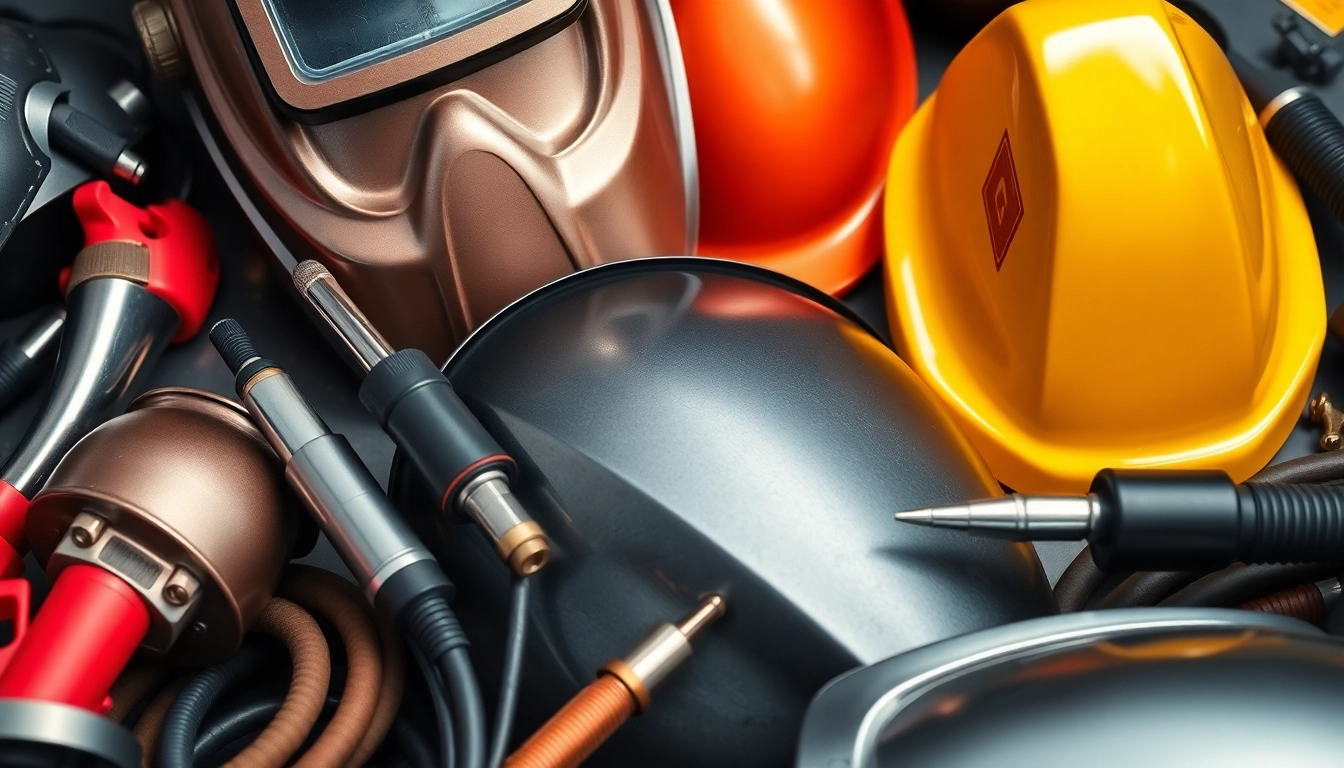Understanding Welding Supplies
Welding is an integral part of many industries, from construction to manufacturing and automotive. At its core, effective welding performance relies heavily on the welding supplies used. Whether you are a beginner or an experienced welder, understanding the types of welding supplies available is crucial to achieving quality results in your projects. In this comprehensive guide, we will explore everything related to welding supplies, from essential gear to advanced tools, and help you make informed decisions.
What Are Welding Supplies?
Welding supplies refer to the tools, materials, and safety equipment necessary for welding jobs. This includes both the machinery used to perform welding, such as MIG and TIG welders, and the consumables required to make a weld, such as electrodes and gas. Additionally, safety gear is a vital component to protect welders from the hazards associated with their work.
Essential Welding Gear for Beginners
For those just starting in welding, having the right equipment is critical. Beginners typically need the following essentials:
- Welding Helmet: Essential for protecting the eyes and face from the bright arc and harmful UV rays.
- Welding Jacket: Made of flame-resistant materials, this helps protect the body from sparks and heat.
- Welding Gloves: Designed to provide a secure grip while protecting hands from heat and electrical shock.
- Safety Glasses: Extra protection against flying particles when not actively welding.
These items form the foundation of a welder’s toolkit and provide a baseline for safety and effectiveness in the welding process.
Advanced Tools and Equipment for Professionals
As one gains experience in welding, the need for more advanced tools becomes apparent. Professional welders often invest in tools such as:
- MIG and TIG Welders: Versatile machines that allow for different types of welding projects.
- Plasma Cutters: Used for cutting metal quickly and with precision.
- Welding Positioners: Tools that help maintain the workpiece at the proper angle for welding.
- Fume Extractors: Vital for ensuring a safe working environment by removing harmful gases.
These components elevate a welder’s capabilities, allowing for more complex projects and higher quality outcomes.
Types of Welding Supplies Available
Welding supplies can be categorized into various types based on their function and application. Understanding these categories can help welders select the right supplies for their needs.
MIG and TIG Welding Supplies
MIG (Metal Inert Gas) and TIG (Tungsten Inert Gas) welding supplies play specific roles in welding processes:
- MIG Supplies: These include MIG welders, welding wires, and shielding gases. MIG welding requires a continuous feed of wire, making it faster and easier for beginners.
- TIG Supplies: TIG welding utilizes tungsten electrodes and requires additional materials, such as filler metals. This method is more complex and offers finer control, making it ideal for intricate welding tasks.
Choosing between MIG and TIG depends on the project requirements and the welder’s level of expertise.
Safety Equipment: Helmets and Gear
Safety cannot be overstated in welding. The right safety equipment not only protects welders from immediate hazards but also from long-term health risks. Essential safety equipment includes:
- Auto-Darkening Helmets: These helmets adjust automatically to changing light conditions, providing optimal eye protection.
- Face Shields: Offers additional face protection when performing tasks that create flying debris or heat.
- Respiratory Protection: Necessary for environments with fumes or dust that could impact lung health.
Investing in high-quality safety gear is a critical decision for any welder, as it significantly reduces injury risk and enhances comfort during work.
Consumables: Electrodes and Wires
Any welding process requires consumables, which are materials that are used up during the welding operation. Key consumables include:
- Electrodes: In stick welding, electrodes are used to produce the electrical arc and contribute to the weld quality.
- Welding Wires: For MIG welding, the continuous wire feed is essential for creating strong welds.
- Filler Materials: Used in TIG welding and other processes to fill gaps and support weld integrity.
Choosing the right consumables is essential for achieving the desired weld strength and quality.
Choosing the Right Welding Supplies
Selecting welding supplies can be overwhelming given the multitude of options available. Here are some guiding factors to consider when making these decisions:
Factors to Consider When Buying
When purchasing welding supplies, consider the following factors:
- Type of Welding: Determine whether you will be doing MIG, TIG, Stick welding, or another type as this will dictate your choice of equipment and supplies.
- Budget: Establish a budget that accommodates the essential tools and materials needed for your projects and don’t forget to account for quality as a priority.
- Durability: Investing in rugged and high-quality products can save you money in the long run by reducing the need for frequent replacements.
- Brand Reputation: Research reputable brands known for their quality and durability in the welding industry.
By assessing your needs against these factors, you can make informed purchasing decisions that align with your welding goals.
Comparing Brands: Reliability and Quality
Brand comparison is an essential consideration, especially in industries that rely heavily on equipment performance. Key attributes to evaluate include:
- Warranty: A longer warranty often signifies confidence in product durability and reliability.
- Customer Reviews: Read user experiences to gain insight into the product’s real-world performance.
- Availability of Parts: Brands with good support networks often make it easier to obtain necessary replacements or accessories.
Assessing these factors can lead to long-term satisfaction with your welding supplies and equipment.
Where to Find Discount Welding Supplies
Cost-saving options for welding supplies can be found through various channels:
- Online Suppliers: Websites like Cyberweld and WeldingSupply.com often provide competitive pricing and promotions.
- Local Hardware Stores: Sometimes they carry sales on bulk welding supplies.
- Industry Trade Shows: A great place to strike deals and find out about new products.
Finding the right discounts can make a significant difference in managing your welding costs while still acquiring quality supplies.
Maintaining Your Welding Supplies
Preventative maintenance can extend the life of your welding supplies and equipment significantly. Here are essential practices to ensure longevity:
Cleaning and Storing Welding Gear
Proper cleaning and storage are vital for maintaining welding gear:
- Regular Cleaning: Clean your equipment after each use to remove slag, dust, and other contaminants.
- Storage Conditions: Store welding supplies in a dry, clean environment away from extreme temperatures and moisture.
- Inspection: Regularly check your equipment for wear and tear, ensuring that parts are in working order.
By establishing a routine for cleaning and storage, you can prevent premature damage and functionality decline.
Extending the Life of Your Equipment
In addition to regular cleaning and inspection, here are some tips to enhance the longevity of your welding machines:
- Follow Manufacturer Guidelines: Adhering to usage and maintenance instructions is crucial to preserving your warranty.
- Use Appropriate Settings: Always calibrate your equipment to match the welding task at hand.
- Keep Spare Parts on Hand: Having critical components available can aid in quick repairs when needed.
Implementing these practices will help ensure that your welding supplies perform at optimal levels over time.
Common Issues and Troubleshooting Tips
Even the best equipment may encounter issues over time. Some common welding problems include:
- Inconsistent Arc: Ensure that your welding machine settings, including voltage and wire feed speed, are correctly adjusted.
- Spatter: Check the chosen gas and its flow rate; using a higher gas flow can help minimize spatter.
- Weak Welds: Ensure adequate cleaning of the workpiece before welding to promote better adhesion.
Being prepared with troubleshooting knowledge can save time and ensure a successful welding outcome.
Conclusion: Making Smart Choices in Welding Supplies
In conclusion, understanding the ins and outs of welding supplies will empower both beginners and experienced welders to make smart purchasing choices. By considering factors like the type of welding, budget, brand quality, and maintenance, you can ensure long-term success in your welding endeavors.
Recap of Key Points
To summarize, ensure that you evaluate:
- The types of welding and corresponding supplies needed.
- Safety equipment to protect against hazards.
- Durability and reliability when choosing brands and supplies.
- Continuous maintenance to extend the life of your equipment.
Looking to the Future: Innovations in Welding Equipment
The welding industry is constantly evolving with new technologies aimed at improving efficiency and safety. Future innovations may include automated welding solutions, enhanced safety gear with integrated technologies, and more eco-friendly welding consumables.
Encouragement to Invest in Quality Supplies
Investing in high-quality welding supplies is an investment in your skills and your projects’ success. With the right tools, equipment, and knowledge, the possibilities in welding are limitless. Focus on building a well-rounded toolkit that supports your current and future projects.


